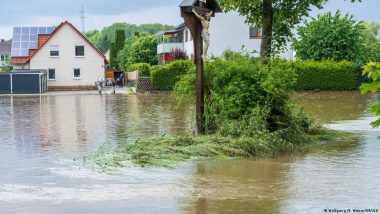German meteorologists say the country's recent catastrophic flooding is the result of a rare "Vb" weather system, which they say could worsen with climate change.If you read German reports about the recent flooding disaster in the southern part of the country, you will likely come across mention of "Vb weather conditions."
These conditions, which are seldom reported in English papers, were first described in 1891 by German meteorologist Wilhelm Jacob van Bebber, who cataloged typical paths of low-pressure systems and labeled them with Roman numerals.
Also Read | China's Chang'e-6 Takes Off After Collecting First Samples From Far Side of Moon.
Although the terms Va, Vc and Vd have since fallen out of popular usage, Vb (pronounced five-B weather conditions, V = Roman 5) is still used by meteorologists to describe a rare pressure system that can bring heavy rainfall, and often catastrophic damage, to Europe.
Unusual trajectory
In Europe, weather is often determined by low pressure systems that move across the continent from west to east. In a Vb weather situation, however, the path of the low pressure system changes: The low pressure system moves towards the Mediterranean Sea due to colder air masses over western Europe.
Depending on the position of the core, such low pressure areas in the Mediterranean are also known as Genoa, Adriatic or Balearic lows.
The low pressure area pushes very humid air from the Mediterranean region past the eastern side of the Alps and north across the Czech Republic and Poland to Scandinavia.
As it moves across Europe, the low pressure system causes heavy precipitation — like the current flooding in southern and eastern Germany.
Mediterranean lows bring rain to southeastern Europe's mountains
Mediterranean lows generally pump warm air masses from the Sahara across the Eastern Mediterranean.
There, the lows usually accumulate moisture, causing heavy rain in southern European mountain areas. This not only affects the Alps, but also the Pyrenees, Dinarides, Carpathians and Rhodopes, among others.
Strong Mediterranean lows generally occur in winter. In exceptional cases, a Mediterranean low can form a cloud-free area in the center, sort of like the eye of a hurricane.
Hurricane Daniel, which hit Europe in September 2023, offers an example of this system at work. The storm, which first hit in the Eastern Mediterranean, caused flooding in southeastern Europe and North Africa, pummeling Greece, Libya, Bulgaria and Turkey with heavy rainfall.
Flooding due to sluggish Mediterranean lows
Although they can develop at any time of the year, Vb weather conditions usually occur in spring and fall, when a strong exchange occurs between the cold northern and warm southern air masses.
Such conditions can present for several weeks on end: one Mediterranean low follows the next, each channeling humid air to the north.
In such situations, the problem is not only a large amount of water, but, above all, a lack of wind.
As a result, Mediterranean lows often move very slowly or even stop, causing massive amounts of rain to fall on a limited area. If these precipitation events go on long enough, the ground can become so soaked that it loses its ability to absorb more water, causing flooding.
The warmer the Mediterranean and the air above it, the more water moves north with the low pressure area. This is why Vb situations have led to catastrophic flooding in the past, especially in summer.
Germany's 2002 "flood of the century", which occurred near the country's Elbe river in the month of August, is a well-known example of a Vb weather situation.
Potential of worsening due to climate change
Forecasts show climate change could cause Vb weather conditions to become more extreme.
Although there will be fewer summertime Mediterranean lows in the coming decades, according to meteorologists, climate change will cause the atmosphere to warm, allowing for increased absorption of water vapor and subsequent rainfall.
Climate change may also have an effect on the jet stream. At high altitudes, this broad band of very strong westerly winds over the Arctic determines the wind conditions and therefore the weather. Recently, the jet stream has shifted significantly to the south.
This could also bring about serious weather changes, such as very long periods of precipitation or phases of extreme heat in the fall.
This article was originally published in German.
(The above story first appeared on LatestLY on Jun 04, 2024 07:00 PM IST. For more news and updates on politics, world, sports, entertainment and lifestyle, log on to our website latestly.com).













 Quickly
Quickly




















